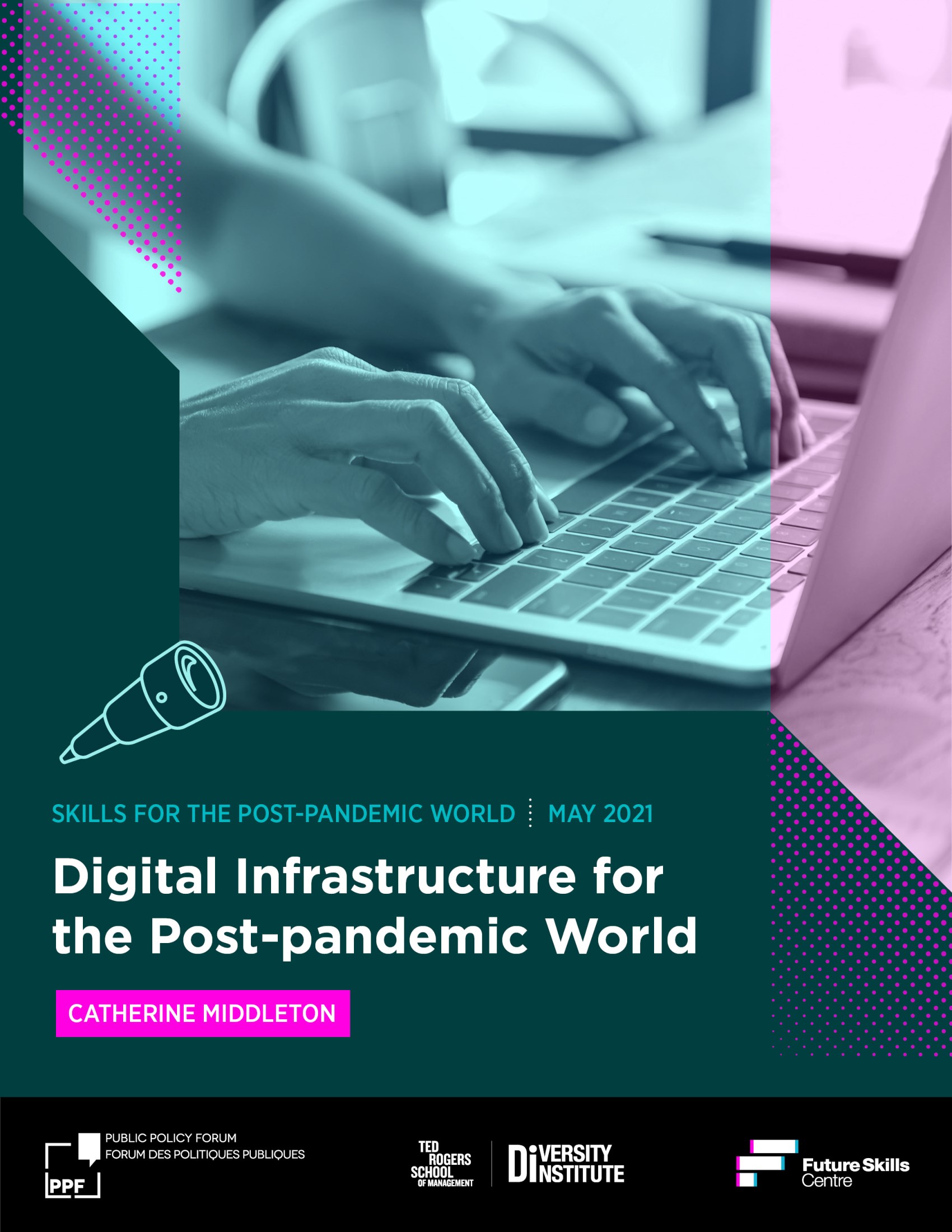Digital Infrastructure for the Post-Pandemic World
Canada | 2021
If Canadians thought the country was speeding towards a digital economy before the pandemic, they couldn’t help but feel it had arrived — virtually overnight — after the virus touched down in Canada.
Indeed, the need for Canadians to work and study from home to “flatten the curve” has become the foundation for much business activity today. When lockdowns hit in March 2020, many working lives, not to mention social lives, went from in-person to online. A total of 4.7 million Canadians who do not normally do so started working from home. As of December 2020, nearly a third of Canada’s workforce was still working from home, including 2.8 million people who would not normally do so.
Ironically, while digital business and education theoretically could ensure better access to both for a large number of Canadians, restricted internet access will block this for many. In short, digital transformation has been experienced unevenly and, at least so far, has served to deepen some inequalities rather than ease them.
This report examines the components of Canada's essential digital infrastructure system, and highlights worrying inequalities that exist within this system. It also offers recommendations on how to quickly reduce some of the most glaring obstacles that prevent many of those who would benefit the most from digital training, education and employment opportunities from accessing it.
Key Takeaways
- Geography and affordability are two key factors in accessing the digital infrastructure households need to work from home or participate in online learning. Remote locations often only have access to shoddy connections and that come at a price that is several times higher than what urban Canadians are asked to pay. Those with lower incomes — regardless of where they live — often find the costs of such services prohibitive.
- The communities that are most vulnerable to marginalization in the new digital economy — Indigenous people, immigrants, low-income Canadians of all ethnic backgrounds, and those who live in remote locations — are also those who have the most to gain from the greater availability of remote work options and more accessible online skills training. Policies that address this disparity must keep that top of mind.
Recommendations
This report focuses on initiatives that can be implemented in the short term to increase accessibility to online training and improve the availability of digital infrastructure. Among them:
- Public internet access points;
- Financial support for household internet access;
- Awareness and sustainability of digital infrastructure initiatives; and
- Exploring training opportunities enabled by television and telephone
L’Infrastructure numérique dans un monde postpandémique
Si les Canadiens et Canadiennes croyaient que le pays fonçait vers une économie numérique avant la pandémie, ils ne pouvaient que croire que cela s’était fait – virtuellement du jour au lendemain – lorsque le virus a atterri au Canada.
En fait, la nécessité, pour les Canadiens et les Canadiennes, de travailler et d’étudier à partir du domicile afin d’aplanir les courbes d’infection de la pandémie est devenue le fondement même d’une bonne partie de l’activité commerciale d’aujourd’hui. Lorsque les confinements nous ont pris de court en mars 2020, dans bien des cas, la vie au travail, et encore plus la vie sociale, sont passées du « en personne » à « en ligne ». Au total, 4,7 millions de Canadiens et Canadiennes ont commencé à travailler à domicile. En décembre, 2,8 millions – près du tiers de la population active canadienne, continuaient à fonctionner ainsi.
Ironie du sort, tandis que les entreprises et l’enseignement, passés au numérique, pouvaient théoriquement offrir un meilleur accès au travail et aux études pour un plus grand nombre de Canadiens et de Canadiennes, les restrictions d’accès à l’Internet constituaient pour beaucoup un empêchement. En bref, la transformation au numérique a été ressentie de façon inégale et a servi à amplifier certaines inégalités par des obstacles structuraux et sociétaux discriminatoires.
Ce rapport examine les éléments clés du système d'infrastructure numérique essentiel du Canada, met en évidence les inégalités inquiétantes qui existent au sein de ce système et propose des recommandations sur la façon de réduire rapidement certains des obstacles les plus flagrants qui empêchent bon nombre de ceux qui en bénéficieraient le plus d'accéder à la formation, opportunités d'éducation et d'emploi par voie numérique.
Points Clés
- La géographie et l’abordabilité sont deux éléments clés déterminant l’accès à l’infrastructure numérique dont les Canadiens et Canadiennes ont besoin pour travailler de la maison et participer à des cours en ligne. La connexion dans les régions éloignées est souvent de mauvaise qualité et bien plus chère que dans les régions urbaines. Les personnes à faible revenu, quel que soit leur lieu de résidence, considèrent le prix des services Internet et de téléphonie cellulaire souvent comme prohibitif.
- Les communautés les plus à risque de marginalisation dans la nouvelle économie numérique, soit les Autochtones, les immigrantes, les Canadiens et Canadiennes à faible revenu de toutes origines ethniques et les personnes dans les régions éloignées, sont aussi celles qui bénéficieraient le plus des nouvelles façons de travailler et d’étudier. Cette réalité doit faire partie de la réflexion pour élaborer des politiques visant à éliminer les disparités.
Recommendations
Le présent rapport se concentre sur des initiatives exécutables à court terme pour augmenter l’accessibilité à la formation en ligne et offrir une meilleure disponibilité de l’infrastructure numérique. Mentionnons notamment :
- Points publics d’accès à Internet;
- Soutien financier pour l’accès Internet des ménages;
- Connaissance des initiatives relatives à l’infrastructure numérique et de leur durabilité;
- Étude des possibilités de formation facilitées par la télévision et le téléphone
Published:
May 2021
Skills for the Post-Pandemic World
Les compétences dans un monde postpandémique
![PPS Feature Image [Converted] [Recovered]](/content/dam/diversity/research-projects/Skills-for-the-post-pandemic-world.jpg)
The Skills for the Post-Pandemic World (opens in new window) project tackles key questions facing policymakers, employers, training providers and workers. It is urgent that society turn to face the fundamental changes in the labour market precipitated by the COVID-19 pandemic, and many players must rise to meet the new conditions of a post-pandemic world.
Building on the collaborative success of the Skills Next (opens in new window) series, the Public Policy Forum (external link) (PPF) and the Diversity Institute (DI), funded by the Future Skills Centre (external link) (FSC), and with new support from Microsoft, join once more to face these rapid societal shifts head-on, with research looking at the future of skills, training and retraining in ways that will chart a path forward as the pandemic continues to unfold.
 Les compétences dans un monde postpandémique (opens in new window) aborde des questions clés auxquelles sont confrontés les décideurs.euses politiques et les employeurs.euses. Il est urgent pour la société de faire face aux profonds changements dans le marché du travail que la pandémie de COVID-19 a accélérés et pour de nombreux acteurs.trices de s’adapter aux nouvelles réalités d’un monde postpandémique.
Les compétences dans un monde postpandémique (opens in new window) aborde des questions clés auxquelles sont confrontés les décideurs.euses politiques et les employeurs.euses. Il est urgent pour la société de faire face aux profonds changements dans le marché du travail que la pandémie de COVID-19 a accélérés et pour de nombreux acteurs.trices de s’adapter aux nouvelles réalités d’un monde postpandémique.
S’appuyant sur le succès de la série collaborative Compétences de l’avenir (opens in new window) , le Forum des politiques publiques (external link, opens in new window) (FPP) et le Diversity Institute (opens in new window) (DI), financés par le Centre des compétences futures (external link, opens in new window) (CCF) et avec un nouveau soutien de la part de Microsoft, font équipe une fois de plus pour aborder de front ces rapides changements sociaux et étudier les compétences, la formation et le recyclage professionnel de l’avenir de façon à dessiner une trajectoire à suivre à mesure que la pandémie suit son cours.

